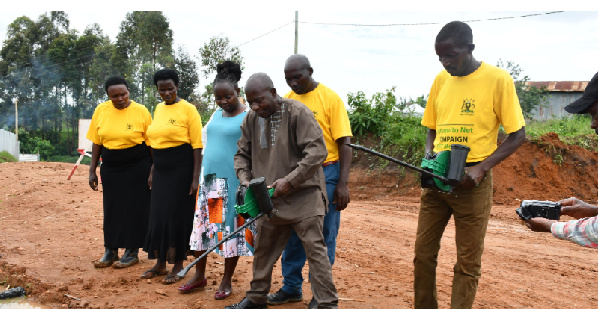
A senior Entomologist at the Ministry of Health demonstrates larviciding to the Village Health
KAMPALA, Nov 2 (NNN-AGENCIES) — Uganda’s Ministry of Health has launched the use of larvicide, a new method of reducing the malaria burden, in Ankole Sub-region.
A larvicide is a type of insecticide used to control mosquitoes indoors and outdoors around homes by killing larvae.
According to the World Health Organisation, Uganda ranks third in global malaria burden with more than 12 million cases reported annually. Three out of 10 sick people in the country suffer from malaria.
During the launch of the initiative in Mitooma District on Monday, the Permanent Secretary at the Ministry of Health, Dr Diana Atwine, who was represented by the programmes officer of vector-borne and neglected tropical diseases at the ministry, Dr Alfred Mubangizi, said malarial transmission will gradually reduce when the method is implemented.
“The ministry is doing everything possible to reduce malaria in the whole country, some of the interventions are long-lasting [like] insecticide-treated nets distribution, indoor residual spraying but these are for indoor control yet mosquitoes can bite you when you are still outside the house. Therefore, the Ministry of Health adopted a new intervention method by applying the herbal medicine (larvicide) to mosquito breeding areas like swamps and stagnant water to kill the mosquito larvae,” Dr Atwine said.
She said the new method only targets mosquito larvae and is not harmful to human beings and aquatic animals, adding that the ministry will continue supplying larvicide to reach all the areas with high malarial prevalence.
Dr Mubangizi said the powdered larvicide is extracted from chlorophyll of plants and is sprayed into mosquito breeding habitats killing the larvae before they turn into adult mosquitoes.
“The mosquito has four stages; eggs, larvae, pupa, and adult but at the larvae stage is when they are eating too much, when this powder is put in the water in the breeding sites, they feed on it and eventually die,” he said.
Dr Mubangizi said a similar programme has been launched in Kigezi and Lango sub-regions.
The ministry official added that larvicide has been approved by both the National Environmental Authority and National Drug Authority as being safe.
Vincent Katamba, a senior entomologist at the ministry, who is spearheading the programme, said they will work with village chiefs and village health teams to identify sites.
“We will be basing on 3Fs to identify these sites that are fixed, foundable, and few. Sites that don’t qualify under that criteria like in homes, the communities can identify and destroy them (larvae),” Mr Katamba said.
He said every six milligrams of larvicide is applied in a square metre of a breeding ground.
The district health officer, Dr Sadic Byamugisha, said the new tool will reduce the malaria burden, especially in areas neighbouring Queen Elizabeth National Park.
“Malaria prevalence rate in Mitooma is at 43 percent, the disease burden is especially high in areas neighbouring the national park. With both indoor and outdoor interventions, we are hopeful the malaria burden will be reduced,” he said. — NNN-AGENCIES





